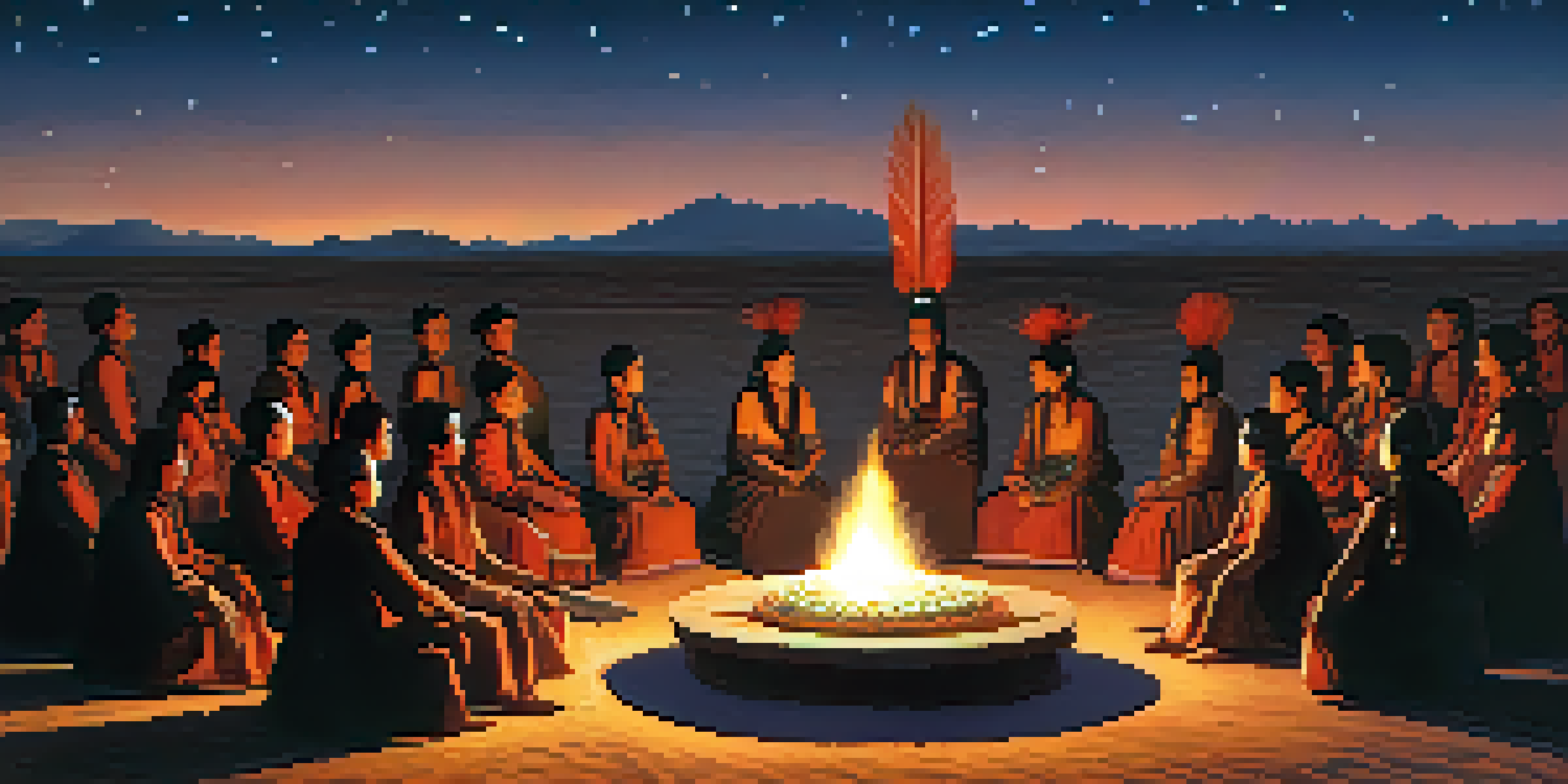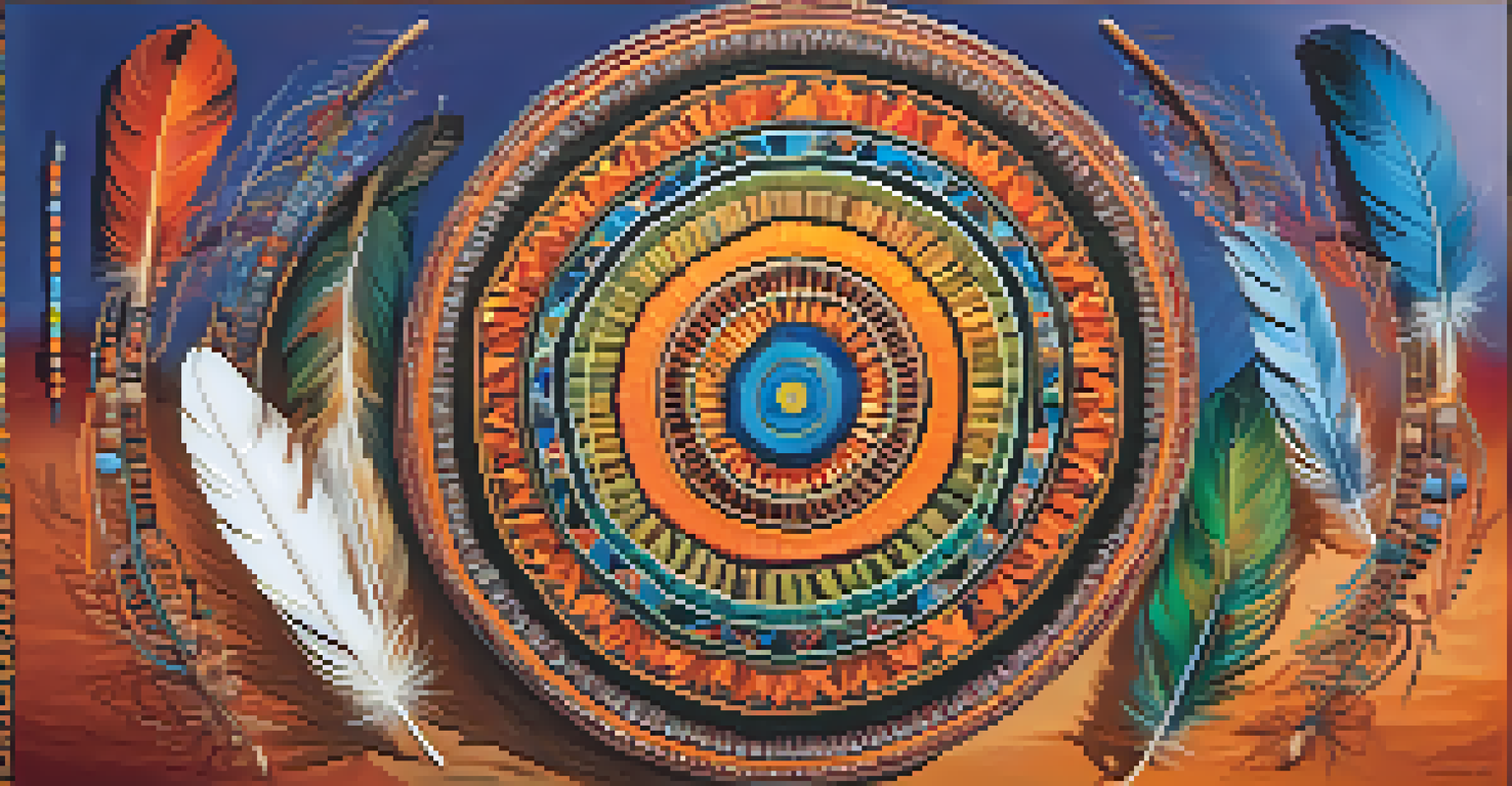Interpreting Symbols: Visual Language in Peyote Rituals

Understanding Peyote Rituals and Their Cultural Context
Peyote rituals are deeply rooted in the spiritual practices of Indigenous peoples, particularly in North America. These ceremonies often involve the use of peyote, a cactus that contains psychoactive properties, facilitating a unique connection to the spiritual world. Understanding the cultural context of these rituals is essential to appreciating their significance and the role symbols play within them.
Symbols are the language of the spirit, a way for the heart to communicate its deepest truths.
For many, these rituals are not just about the peyote; they are a profound expression of identity, community, and spirituality. Participants engage in songs, prayers, and dances, all of which are laden with symbolism. Each element serves a purpose, communicating messages that might otherwise be lost in translation.
By interpreting these symbols, we can better comprehend the values and beliefs that underpin these ceremonies. This understanding fosters a greater respect for the traditions and the people who practice them, bridging the gap between cultures and highlighting our shared human experience.
The Role of Symbols in Peyote Ceremonies
Symbols in peyote rituals serve as visual language, conveying complex ideas and emotions. For instance, the peyote cactus itself is a powerful symbol of healing and transformation. Through its consumption, participants often seek insight, guidance, and connection to the divine, making it central to the ritual's purpose.

Additionally, other symbols, such as the circle, are commonly employed in these ceremonies to represent unity and wholeness. The circular formation of participants during rituals emphasizes the interconnectedness of life, reinforcing the idea that every individual is part of a larger community. This symbolism fosters a sense of belonging and shared experience.
Symbols Enhance Peyote Rituals
Symbols in peyote rituals convey complex ideas and emotions, enriching participants' spiritual experiences.
Understanding these symbols is crucial for those participating in or observing the rituals. It allows for a deeper engagement with the practices, enabling individuals to appreciate the layers of meaning embedded in each action and element, enriching the overall experience.
Common Symbols Found in Peyote Rituals
Within the context of peyote rituals, several common symbols frequently appear, each carrying its own unique meaning. For example, feathers often symbolize spiritual elevation and connection to the divine. They may be used in ceremonial attire or as offerings, representing the participant's desire to reach higher states of consciousness.
The drum is the heartbeat of the Earth, connecting us to the rhythm of life and the universe.
Another prevalent symbol is the drum, which provides the rhythmic heartbeat of the ceremony. The drumbeat serves not only as a musical accompaniment but also as a metaphor for the pulse of life itself, reminding participants of their connection to nature and one another. It's a powerful tool for setting the atmosphere and deepening the spiritual experience.
Additionally, the use of colors in ceremonial decorations and attire can carry significant meanings. Different colors may represent various elements, emotions, or spiritual concepts, enriching the visual language of the ritual. Understanding these symbols helps participants and observers alike to grasp the depth of the experience more fully.
Interpreting Visual Symbols: A Guide for Participants
For those new to peyote rituals, interpreting visual symbols can initially seem daunting. However, approaching these symbols with curiosity and an open mind can lead to profound insights. One effective way to begin is by asking questions and seeking guidance from experienced participants or leaders.
Keeping a journal during the ceremony can also be beneficial. Participants can jot down their observations, feelings, and interpretations of the symbols they encounter. This practice not only aids in memory retention but also encourages personal reflection, fostering a deeper connection to the experience.
Emotional Connections Through Symbols
The visual language of symbols evokes powerful emotions, fostering a sense of community and belonging among participants.
Engaging with the symbols on a personal level can also enhance understanding. Reflecting on what a particular symbol means to you can open up new avenues of interpretation and meaning, making the ritual more impactful and personally relevant.
The Emotional Impact of Symbols in Peyote Rituals
Symbols in peyote rituals often evoke powerful emotions, contributing to the transformative nature of the experience. For many participants, the visual language of the ceremony can trigger deep-seated feelings of connection, healing, and belonging. This emotional resonance is an integral part of the ritual's purpose, allowing individuals to explore their inner landscapes.
For instance, seeing symbols that represent ancestors or cultural heritage can invoke a sense of pride and continuity. Participants may feel a stronger connection to their lineage and the wisdom of those who came before them, enriching their spiritual journey. This emotional connection can lead to profound realizations and personal growth.
Moreover, the shared experience of interpreting these symbols within a community can amplify their emotional impact. When participants collectively engage with the visual language of the ritual, it fosters a sense of solidarity and support, making the journey even more meaningful.
Preserving Symbolic Meaning in Modern Contexts
As peyote rituals gain recognition beyond their traditional roots, preserving the symbolic meaning associated with them is vital. In modern contexts, it's essential to approach these symbols with respect and understanding, ensuring they are not misappropriated or diluted. This preservation helps maintain the integrity of the rituals and the cultures they represent.
Education plays a crucial role in this process. By sharing knowledge about the significance of symbols, we can foster a greater appreciation for their importance within the rituals. Workshops, discussions, and written materials can all contribute to a more nuanced understanding of these practices.
Preserving Symbolic Meanings Today
Maintaining the integrity of symbolic meanings in modern contexts is crucial to honoring the traditions of Indigenous cultures.
Additionally, collaborating with Indigenous leaders and communities is essential in maintaining authenticity. Listening to their perspectives and honoring their traditions ensures that the symbolic meanings remain intact, allowing future generations to experience the richness of peyote rituals in their full context.
Conclusion: The Power of Symbols in Peyote Rituals
In conclusion, symbols play a pivotal role in peyote rituals, serving as a visual language that communicates complex ideas and emotions. By understanding and interpreting these symbols, participants can deepen their connection to the rituals and the spiritual journeys they undertake. Each symbol, from the peyote cactus to the drum, contributes to a rich tapestry of meaning that enhances the overall experience.
The power of these symbols extends beyond the individual, fostering a sense of community and shared understanding among participants. As we engage with these visual languages, we not only honor the traditions they represent but also enrich our own spiritual journeys.

Ultimately, the exploration of symbols in peyote rituals invites us to reflect on our own connections to culture, spirituality, and the natural world. In doing so, we can appreciate the profound impact these symbols have, reminding us of the shared human experiences that unite us all.